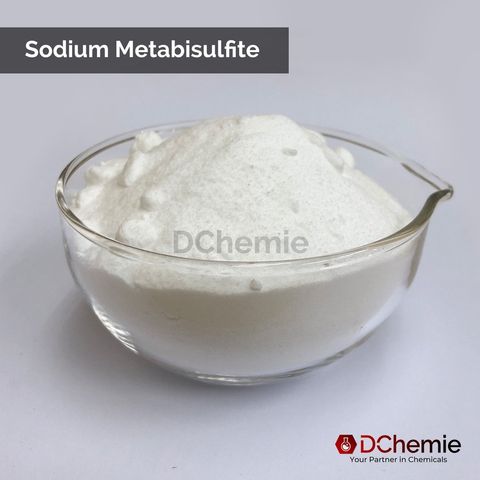
Sodium metabisulfite is a chemical compound with the formula Na₂S₂O₅. It appears as a white or pale yellow powder with a strong sulfur-like smell. This compound is highly soluble in water and, when dissolved, it releases sulfur dioxide (SO₂), a gas that plays a key role in its many applications. Sodium metabisulfite is known for its ability to preserve products, prevent oxidation (damage caused by exposure to air), and act as a cleaning or bleaching agent.
This chemical is widely used in a variety of industries due to its versatility and effectiveness. In the food industry, it helps to keep products fresh and prevent discoloration. In water treatment, it removes unwanted chemicals like chlorine. It is also important in making medicines, processing textiles, and even mining metals. Sodium metabisulfite is valued for being cost-effective, easy to use, and reliable in many industrial processes.
Function and Uses
Sodium metabisulfite serves several important functions:
- Preservative: It inhibits microbial growth, extending the shelf life of food and beverages.
- Antioxidant: It prevents oxidation, which can cause discoloration and spoilage in products.
- Reducing Agent: It neutralizes oxidative compounds, making it valuable in chemical processing and water treatment.
- Bleaching Agent: In textiles and paper production, it helps whiten materials.
- pH Control: It helps keep the pH levels stable and within the desired range in different products.
Applications

Sodium metabisulfite is utilized in diverse industries due to its multifunctional properties. Below are its applications, categorized by industry:
1. Food and Beverage Industry
- Function: Acts as a preservative and antioxidant to prevent spoilage and discoloration in food products.
- Applications:.
- Prevents browning in dried fruits like apricots and apples
- Preserves the freshness of juices, wines, and canned vegetables.
- Stabilizes dough in baking.
- Examples: Dried fruits, fruit juices, jams, wines, and pickles.
2. Pharmaceutical Industry
- Function: Serves as an antioxidant and stabilizing agent in drug formulations.
- Applications:
- Protects active ingredients in injectable medications.
- Stabilizes vitamin C formulations.
- Examples: Injectable drugs, vitamin supplements, and effervescent tablets.
3. Water Treatment
- Function: It works as a reducing agent to remove leftover chlorine and chloramines from water.
- Applications:
- Removing chlorine from water in municipal and industrial systems.
- Treating wastewater to make it safe before releasing it.
- Examples: Municipal water systems and industrial effluent treatment plants.
4. Textile and Leather Industry
- Function: Used as a bleaching and reducing agent.
- Applications:
- Bleaches wool, silk, and synthetic fibers.
- Aids in leather processing by removing excess chromium.
- Examples: Bleached fabrics and processed leather goods.
5. Paper and Pulp Industry
- Function: Acts as a bleaching agent and reduces excess lignin.
- Applications:
- Brightens paper products.
- Improves pulp quality during manufacturing.
- Examples: High-quality printing paper and writing paper.
6. Mining Industry
- Function: Helps extract precious metals by acting as a reducing agent.
- Applications:
- Used in cyanidation processes to precipitate gold and silver.
- Examples: Gold and silver mining operations.
7. Cosmetics and Personal Care
- Function: Acts as an antioxidant and preservative.
- Applications:
- Stabilizes formulations in creams and lotions.
- Prevents discoloration in hair care products.
- Examples: Skin creams, shampoos, and conditioners.
8. Photographic Industry
- Function: Used as a fixing agent in photographic processing.
- Applications:
- Helps stabilize images during photo development.
- Examples: Black-and-white photographs and X-ray films.
Product Examples

Sodium metabisulfite is an ingredient in products such as:
- Preserved dried fruits and canned vegetables.
- Injectable vitamin C solutions and effervescent tablets.
- Leather goods treated for durability and finish.
- Brightened fabrics and bleached paper products.
- Water purified for municipal and industrial use.
- Photographic films and development kits.
Production/Sources
Sodium metabisulfite is made by combining sulfur dioxide (SO₂) with either sodium carbonate or sodium hydroxide. This creates sodium bisulfite, which is then dried to form sodium metabisulfite crystals.
The main materials used in this process are:
- Sulfur: Used to produce sulfur dioxide gas.
- Sodium Hydroxide or Sodium Carbonate: Used to neutralize the sulfur dioxide and create the compound.
The production process is carefully controlled to ensure the final product is pure and meets industrial standards.
Properties/Characteristics
- Chemical Formula: Na₂S₂O₅
- Appearance: White or slightly yellow crystalline powder.
- Odor: Strong smell similar to sulfur.
- Solubility: Soluble in water, producing an acidic solution.
- Stability: Decomposes at higher temperatures, releasing sulfur dioxide.
Conclusion
Sodium metabisulfite is a useful and versatile chemical with many important applications. It helps preserve food, prevents oxidation, and is used in water treatment, pharmaceuticals, and various industrial processes. Its ability to solve different problems, along with its low cost, makes it a valuable ingredient in many industries. With its wide range of uses, sodium metabisulfite continues to be an essential chemical in everyday products and industrial processes.






